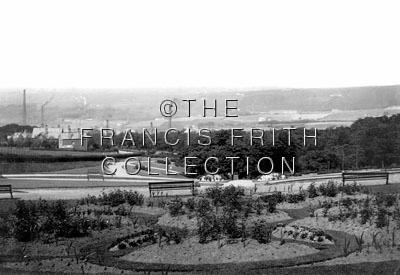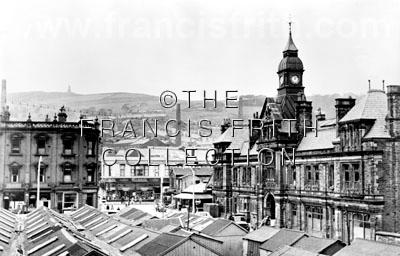DARWEN
This page is still being prepared and will contain a brief history of
Darwen.
  Darwen, Whitehall Park circa
1896.
Darwen, the Market Hall circa
1955
Darwen, Whitehall Park circa
1896.
Darwen, the Market Hall circa
1955
Darwen formerly known as Over Darwen, now includes part of the former
area known as Lower Darwen, Pickup & Yate Bank and Eccleshill.
The imprint of history goes deeply at Darwen. The important road
constructed by the Romans nearly 2,000 years ago from Manchester to
Ribchester and on to Carlisle and into Scotland, can be traced through the
Borough along the hillside on the east of the town, being called Roman Road
between Whittlestone Head and Blacksnape.
After the withdrawal of the Roman legions from Britain in the 5th century
the defenseless country was overrun by Continental invaders who subsequently
settled here. The derivation of various local place names, including that of
the present town of Darwen confirms the fact that this district became
occupied by the Saxons.
Following the Norman Conquest the de Lacy family was granted land and
manorial rights here in the latter part of the 11th century, the name of the
place being recorded as Darwynd. The first reference to Darwen, and what is
now Lower Darwen was in 1154 as the two Darwentas. The former place became
known in 1280 as Superior Derwent, which was recorded as Over Darwen forming
part of the parish of Blackburn in 1616.
The earliest industries at Darwen were farming, quarrying and later coal
mining; but the population of those days was comparatively small, being only
a few hundred people. It is recorded at the beginning of the 18th century
that many of these were 'coal-getters', this improved form of fuel and
industrial power being either cut from the near-surface seams or dug from
pits.
The Wool Industry
The traditional textile trade also developed, with the workers spinning
and weaving the cloth in their own homes both in the town and on the
surrounding farms where much of the raw material was provided by the wool of
the moorland sheep. The industry passed through various phases of relative
prosperity and depression as master weavers gained more and more control.
The merchandise which had originally been taken into surrounding town
markets by the workers themselves was now sent by teams of packhorses, and
the later by wagons. The master weavers took the enhanced profits of better
marketing, paying their employed workers a low wage for long hours of labor,
and housing them under crowded and far from pleasant conditions. Those who
because of sickness or age could no longer put in the required amount of
labor were all too often turned out of their homes.
The Coming of Cotton
With the Industrial Revolution of the 19th century hand looms were
displaced by power looms, and work was concentrated in mills and factories
instead of in houses in the town. A greater output with less labor resulted
in considerable unemployment, and there were strikes and riots. Samuel
Crompton, who is remembered as the inventor of the spinning mule, opened a
mill at Darwen in 1812. There followed much unrest amongst the workers with
considerable rioting in 1826 due to privation resulting from insufficient
work.
The old packhorse routes, were now disused, four turnpike trusts had been
set up to make good roads, the upkeep of these being paid for by the tolls
levied on all traffic. A slower alternative freight transport was by canals.
Then came the railways, the line between Bolton and Blackburn being opened
in 1848. About this time the local paper-staining and wallpaper industry
began to develop.
Practically all the woolen mills had now gone over to cotton; but the
hard times of the 1820's were again experienced with even greater severity
in the early 1860's when the American Civil War cut off all the supplies of
raw cotton from the Southern States into the port of Liverpool. The distress
in Darwen, as in all the other Lancashire cotton towns, now amounted to
famine. The tragedy of these times, although a century ago, still lives on
as a poignant memory.
Conditions subsequently improved with better working and living
conditions and higher pay; but this great Lancashire industry has continued
to fluctuate between trade boons and recessions. Paper has been one of the
town's major industries for more than a century. Other major industries
include engineering, paints and plastics.
Census Information:
1801 3,587 1851 11,702
1811 4,411 1861 16,492
1821 6,711 1871 21,278
1831 6,972 1881
1841 9,348 1891
The written information on this webpage was taken directly from the
following webpage:
http://ourworld.compuserve.com/homepages/GAFOSTER/darwen.htm .
Ownership of the written material belongs to:
Tony Foster
142 Cotswold Crescent, Bury, Lancs BL8 1QP, England
Phone: +44 161 764 2821
The information on
this web site is for your personal use only. All pages, compilations,
transcriptions and abstracts are protected by copyright law and may not be
copied in whole or in part and published or distributed in any manner
without written consent of the author, contributor and/or
webmaster.
Message from
OurFamilyStories.com:
The information and data provided in this website, that hasn't been
identified as belonging to others, is to be used for personal NON-COMMERCIAL
purposes only. It is not to be reproduced in any form for commercial
or profit purposes without the express written permission of
OurFamilyStories.com.
Copyright ©1995,
2004. OurFamilyStories.com. All Rights Reserved.
Your comments &
suggestions are always welcome.
Last Updated 09 June 2004
  

 |